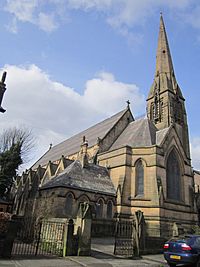Christ Church, Toxteth Park facts for kids
Quick facts for kids Christ Church, Toxteth Park |
|
|---|---|

Christ Church, Toxteth Park, from the southeast
|
|
| Lua error in Module:Location_map at line 420: attempt to index field 'wikibase' (a nil value). | |
| OS grid reference | SJ 370 860 |
| Location | Linnet Lane, Liverpool, Merseyside |
| Country | England |
| Denomination | Anglican |
| Website | christchurchtoxtethpark.org |
| History | |
| Status | Parish church |
| Founded | 1867 |
| Founder(s) | George Horsfall |
| Consecrated | 27 April 1871 |
| Architecture | |
| Functional status | Active |
| Heritage designation | Grade II |
| Designated | 19 June 1985 |
| Architect(s) | Culshaw and Sumners |
| Architectural type | Church |
| Style | Gothic Revival |
| Groundbreaking | 1867 |
| Completed | 1871 |
| Construction cost | Nearly £20,000 |
| Specifications | |
| Materials | Stone, slate roofs |
| Administration | |
| Parish | Christ Church, Toxteth Park |
| Deanery | Wavertree and Toxteth |
| Archdeaconry | Liverpool |
| Diocese | Liverpool |
| Province | York |
Christ Church, Toxteth Park, is a historic church located on Linnet Lane in Liverpool, Merseyside, England. It is an active Anglican parish church, which means it serves the local community.
The church is part of the Diocese of Liverpool and works together with another local church, St Michael's in Aigburth. Because of its historical and architectural importance, it is recognized as a Grade II listed building. This special status helps protect the church for the future.
Contents
History of the Church
Christ Church was built between 1867 and 1871. It was designed by the architectural firm Culshaw and Sumners. The construction was paid for by a wealthy local man named George Horsfall.
The total cost to build the church was almost £20,000. In today's money, that would be worth about £1,330,000! The church was officially opened and blessed on April 27, 1871, by the Bishop of Chester, William Jacobson.
What the Church Looks Like
The church was built in a style called Gothic Revival, which was very popular in the 1800s. This style copied the look of grand medieval cathedrals.
Outside Features
The church is made of stone and has roofs covered in slate. Its design is based on the Decorated style, known for its fancy details.
The main part of the church, called the nave, has a high ceiling with a row of windows called a clerestory. On either side of the nave are walkways called aisles. At the front is a special area called the chancel.
One of the most noticeable features is the tall north tower, which is topped with a broach spire. The tower has openings for the bells and small balconies supported by stone carvings of angels. The large window at the west end of the church has beautiful and complex stone patterns called Geometric tracery.
Inside the Church
Inside, the church has rows of arches called arcades. These arches are held up by slender pillars that are carved with leaf designs at the top. The nave has a special wooden ceiling called a hammerbeam roof, which is a beautiful and complex piece of carpentry.
The floor of the sanctuary (the most holy part of the church) and the decorative screen behind the altar, called a reredos, were added in 1930.
The church is also famous for its stained glass windows. Some of the windows in the apse (the curved area at the front) were likely made by the famous company Hardman when the church was first built. Other windows were added later by artists like Gustave Hiller and Shrigley and Hunt. One of Hiller's windows even shows a picture of the nearby Liverpool Cathedral.
The church has had two large pipe organs. The first was built by C. and J. Whiteley. It was later replaced by a bigger organ made by the well-known company Willis.
The Church Today
Today, Christ Church is a lively and welcoming place. It is an Inclusive Church, which means it is committed to welcoming everyone. The church shares this official statement:
We believe in a church which seeks not to discriminate, on any level <...>. We believe in Church which welcomes and serves all people in the name of Jesus Christ; which is scripturally faithful; which seeks to proclaim the Gospel afresh for each generation; and which, in the power of the Holy Spirit, allows all people to grasp how wide and long and high and deep is the love of Jesus Christ.
Worship services are held every Sunday morning. The church is also very active in the community during the week and helps run a pantry to provide food for local people.
See also
- Grade II listed buildings in Liverpool-L17

